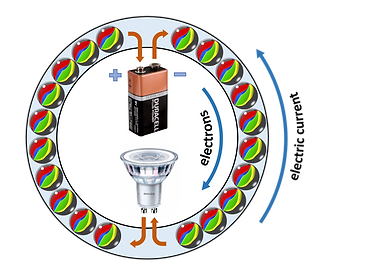
MY STORY,
AND SOME INTERESTING FACTS.

Most people like you may have already heard about the concepts 'Current' and 'Voltage'. Unfortunately, almost none of them don't have any clue about what these two terms really mean while it's actually not that difficult at all. It has been frustrating me for a while and for that reason, I want to make this problem disappear forever by using a brief summary of some fundamental key ideas that you should know to successfully start your carrier as an engineer. Let's start this paragraph with a short fictional story of an electrical connection between Earth and the moon.
Take for instance that you want to turn on a light. You can simply do that by connecting the light ( ) to a battery ( ) using two wires which connect both plus and minus between light and battery. By doing so, the light will switch on immediately. It looks like magic, isn't it? Now imagine for a moment that the light is located on the moon, the battery stays on Earth, and two cables of each 384.400 km (= the distance from Earth to the moon) are provided between light and Earth. If you also connect both wires to the battery on Earth at this point, it would theoretically take around 2,6 seconds* before the light on the moon goes on. This example illustrates that electricity is something physical, something real, and needs its time to propagates through a circuit. But why?

**Structure of an atom that exists of electrons (coloured in grey) orbiting around the nucleus (coloured in blue and red). The nucleus is the core of an atom.
Electric current is known as the flow of electric charge. Unfortunately, no one can tell you what charge is, but only how charges interact and how to use it to describe the wonderful world of physics. Charge is said to be a characteristic that tells you how much a subatomic particle (a particle smaller than an atom) tends to attract or repel another one. There are two and only two types of charges: positive and negative. By convention, particles that carry a negative charge are called electrons. You've probably heard already about electrons, right? It sounds familiar and they are everywhere: in every single atom and thus in any material to think off right now. However, electrons doesn't move freely through any material. You need a conductor, typically a metal, in which the atoms are quite large. This results in a sea of free electrons that don’t belong to any atom in particular (because of the size of the atoms, the electrons orbiting around the nucleus** are more loosely attached). So, in general, a single wire (e.g. a copper conductor) already contains innumerous free electrons that are available to move, even before connecting it to a battery or anything else. Alright, we have quite some free electrons available, but how do we get them off there lazy asses and make them move in order to obtain a flow of electric charge?
The motivator to make them move is called voltage. Voltage is provided by a battery for example. It's kind of a pump that makes the electrons in the conductor move in a never-ending looped pathway, which is called a circuit in terms of electronics. Don't think that a battery adds electrons! It only pumps around the free electrons that are already contained in the wire. That's why a battery has two so called poles (+ and -); to be able to create that unbroken loop where the electrons can continuously flow around (see figure 3, more details later). In summary, the voltage makes the electrons in a conductor move. A flow of electrons causes a flow of charge. This flow of electric charge is called current.
Let's have a look at the light-on-the-moon example again. Perhaps surprisingly, the speed of electricity is not simply equal to the velocity of those electrons. If so, it would take several seconds before a light somewhere in your house turns on if you press a switch downstairs, and we all know that's not the case. An electron namely has a velocity in the order of 0,0001 m/s and that's actually very slow (this velocity is called 'drift velocity' and depends on the electric current and cross sectional area of the wire). However, electricity is defined by the flow of electric CHARGE! The electrons are only the carrier of it. The displacement of the charge goes really really fast, near the speed of light (approx. 300.000 km/s) and thus much faster than a single electron. To understand this line of thought, we can use marbles in a tube as an analogy.

Figure 1: Marble-in-a-tube analogy.
As you can see in the first image, inserting a marble on the left side of the tube produces near instantaneously a marble at the other end. If we take the marbles as electrons and the tube as the wire, we can note that the movement of an individual electron is slow, but the overall net movement of charge is quite rapid, near the speed of light!

Figure 2: Visualization of an electric circuit.

Figure 3: Combination of the marble-in-a-tube analogy with the light-on-the-moon example.
However, figure 1 is not so realistic at all: electrons can't just enter or leave a wire like the marbles represent, and thus no flow of charge will occur in reality. The only solution is to take the wire joined end-to-end, and loop it around so that it forms an unbroken pathway (circuit) for the electrons as shown in figure 2. Hence, charges can flow around in the circuit, continuing forever. Figure 3 combines the marble analogy with a practical example where the 9V battery is the motivator to bring the electrons in motion and to push them through the light. Pay attention to the conventions of directions of flow! Electrons will flow from - to + of the battery. Yet, current is said to go in the other direction (from + to -) because electrons carry a NEGATIVE charge. It's just to make it all mathematically work correctly, but keep in mind that the electrons will thus always flow in the opposite direction of the electric current!
*(384.400 km x 2)/(300.000 km/s) = 2,6 seconds. The length of the circuit is equal to twice the distance from Earth to the moon. The speed of electricity can be considered as equal to the speed of light. However, the speed of electricity is typically on the order of 50%–99% of the speed of light, dependently on the material of the conductor. So, in reality it will take between 2,6 and 5,1 seconds before the light goes on.
Electricity is a physical phenomenon.
No, it's not so magical as it seems to be.
~ Joren Malfroy
About me
Text
Text
If you can't explain it simply, you don't understand it well enough.
~ Albert Einstein
'Will artificial intelligence outsmart us?'. Stephen Hawking gives an answer to this question in his last book 'Brief Answers to the Big Questions' (2018).
"While the short-term impact of AI depends on who is at the controls, the long-term impact depends on whether someone is still at the controls. In short, the emergence of super intelligent AI could be the very best, but could also be the worst event that will ever happen to humanity. The real risk with AI is not malice but competence. A super intelligent AI will be extremely good at achieving its goals. However, if those goals do not align with ours, we have a problem."
Stephen Hawking has warned us about the terrible consequences of artificial intelligence (also abbreviated with AI). Artificial intelligence is the concept where machines 'think like people'. They are able to learn, reason, plan and understand languages. First of all, there are two types of AI: narrow AI (weak), and general AI (strong). What do they mean and what are the differences?
-
Narrow AI
This type of AI is known (and used) by everyone. Hence, machines are able to perform a task extremely well, even better than humans. However, they can't make decisions and do complex tasks like a human brain. They are used for repetitive task and are capable of executing a single task effectively. Some applications can be found in self driving cars, recognition applications, virtual personal assistants (such as Apple's Siri), online recommendations, et cetera.
This type of AI is the frightening one, the one where Hawking is really sceptical about. Machines can be made to think and function as a human mind, and become involved in decision making and analysis. General AI is still in its nascent stage and needs deep research, such as the development towards an artificial neural network that can function like a proper mind.
-
General AI
"Why are we so worried about AI? Can we just not pull the plug at any time?"
-
"People asked a computer: ‘Is there a God?’. And the computer replied: ‘There is now’, and a bolt of lightning struck the plug so it couldn't be turned off."
Let's st

Artificial intelligence (AI) could be the worst event in the history of our civilization.
~ Stephen Hawking
Electric cars are the future, hybrid cars are the transition (present), and a combustion engine is the past. Did you know that an electric engine actually has an efficiency as twice as high as a combustion engine? This means that an electric car can drive twice as far as a nowadays car with the same amount of energy! So, what's the problem? Why are we still driving with these terrible polluting cars if there is such a great alternative on the market?
The problem is pure psychological: we all have 'range anxiety'. We all have fear of getting stuck somewhere with an empty battery, of not finding a charging point, and if, getting stuck at the charging point for a long time. You hear it all coming: it's just a charging problem. The charging time of a car battery does not only depends on the battery itself, but also the charger or in general the charging infrastructure. There are different types of charging powers: Normal, semi-fast, and fast charging.
-
Normal charging
Text
-
Semi-fast charging
Text
-
Fast charging
Text
Blabla
An electric vehicle (EV) is pretty interesting when it's not driving.
~ Johan Driesen - prof. KU Leuven
It's kind of like saying: 'A square is a rectangle, but a rectangle is not necessarily a square'. Robotics is one of many subjects of mechatronics, where mechatronics is the global name of all machines where mechanics and electronics come together.
"Robotics is mechatronics, but mechatronics is not necessarily robotics."
Joren Malfroy
Text
"When voltage goes down, amperage goes up. No, it's not a contradiction to Ohm's law."
Joren Malfroy
Text